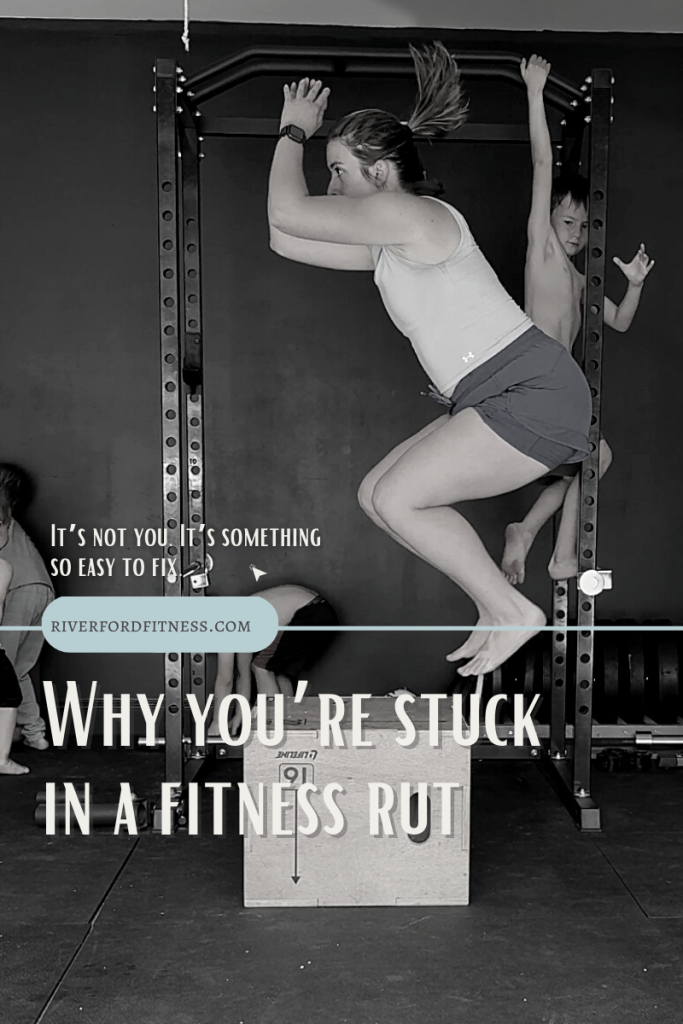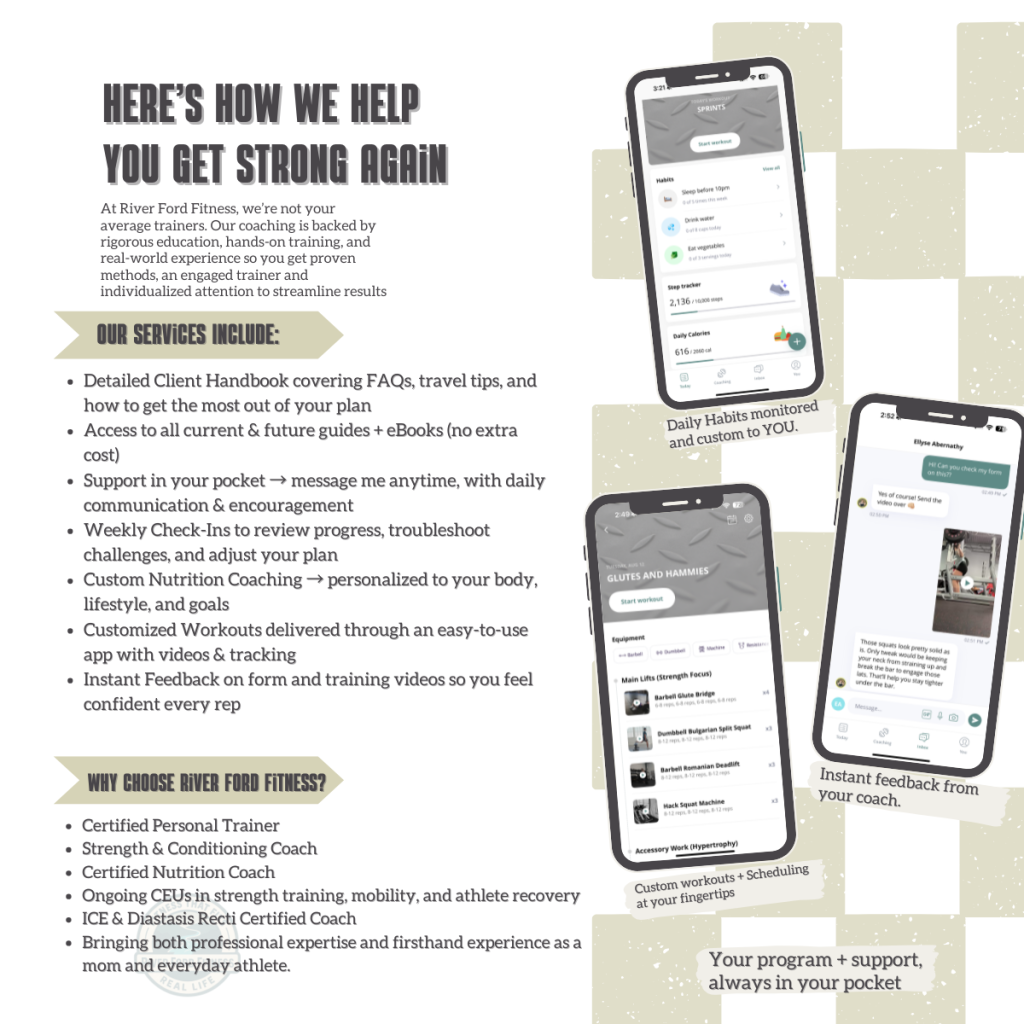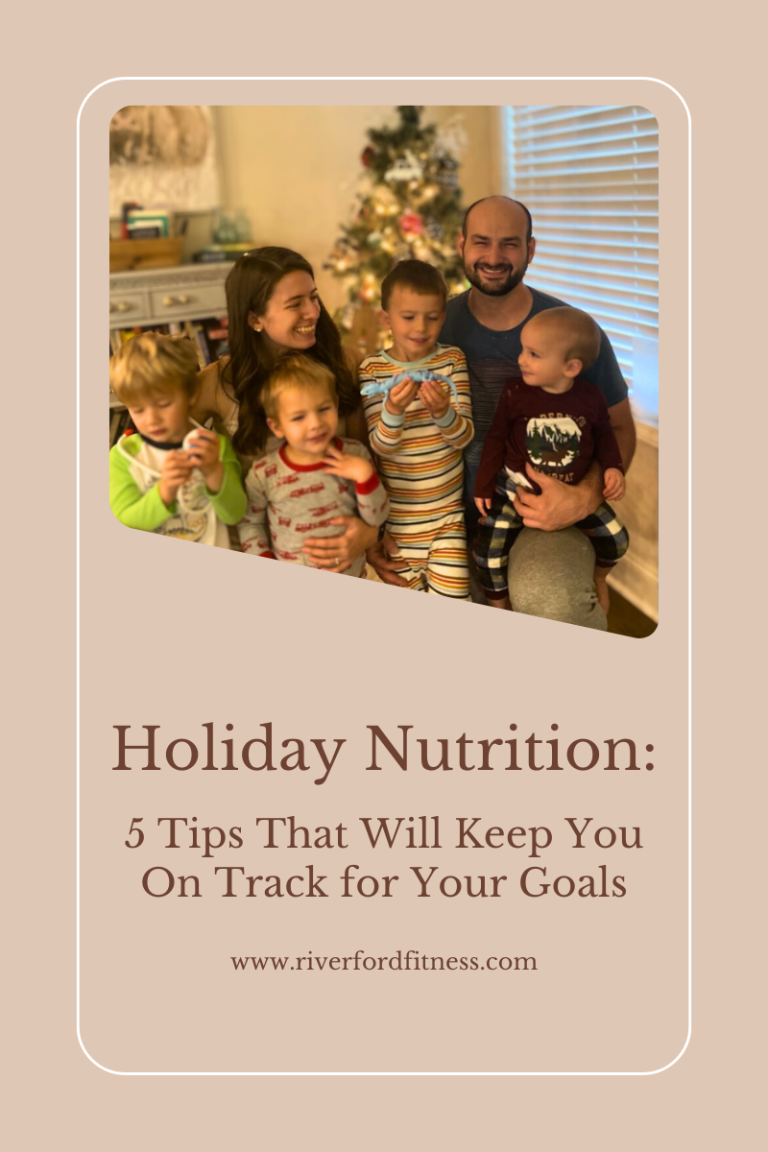You’ve probably blamed yourself for your fitness rut, but before you do that, let me tell you what’s most likely happening. If you’ve been Googling how to get out of a fitness rut, this might surprise you: the real answer isn’t more discipline — it’s understanding stress.

Stress + Why It’s the Hidden Reason You Can’t Get Out of a Fitness Rut
Stress is the fitness progress killer.
When your nervous system is on high alert mode:
1. Muscle activation drops = progress stalled.
This is one of the sneakiest ways stress keeps you stuck when you’re trying to figure out how to get out of a fitness rut.
When your body is chronically stressed, your body’s sympathetic nervous system stays lit (aka your fight-or-flight response).
- This ramps up muscle tone which sounds nice but not that kind of muscle tone. This is low level tension in your body even when your not lifting.
- That constant tension reduced motor unit recruitment efficiency– your brains “FIRE IT UP BOYS” signal
- The result? Your lifts feel heavier and are not executed at optimized capacity.
2. Recovery slow down is fitness rut haven
If you want to know how to get out of a fitness rut, you need to spend as much energy on rest-and-digest as you do on your workouts.
Often times people think the act of working out and tearing down the muscles is what creates strength and muscle size. But it’s actually the muscles ability to rebuild itself optimally that propels progress forward. Your workouts create micro-tears in the muscle tissue and needs the proper fuel and recovery to build back stronger than before.
- But that repair process is heavily dependent on parasympathetic nervous system activation (rest-and-digest mode).
- When you’re in a stressed state, your body prioritizes cortisol-driven survival processes over growth and repair.
- Cortisol can also interfere with protein synthesis (the process of building new muscle) and disrupt sleep quality, which compounds the problem.
- Translation: You stay sore longer, you don’t feel as strong the next session, and the gains trickle in instead of flowing.
3. Metabolism downshifts
This is why so many people feel like they’re trying everything and nothing is working, classic signs of being stuck in a rut. Learning how to get out of a fitness rut often starts with eating more, not less.
Nope, it’s not because your metabolism “just slows down with age” or because of whatever else you might’ve heard from Susie at the supermarket.
Metabolism is actually a highly adaptable, incredibly smart system built to keep you alive. It reads signals from your environment and makes adjustments in real time.
So if you’re constantly stressed, your metabolism is constantly in protection mode.
Here’s what that looks like under the hood:
- Cortisol stays elevated → thyroid hormone conversion (T4 → T3) slows → basal metabolic rate dips.
- Your body unconsciously reduces NEAT (non-exercise movement), think fewer fidgets, less walking, more “I’ll just sit here” moments.
- If recovery is suffering, training output drops too , so you’re burning less during workouts, even if the effort feels high.
It’s not broken or lazy. It’s just responding to the signal you’re sending: “We’re under threat, so conserve.”
And here’s the twist: this is often why eating more actually ends up helping people lose better.
And here’s the twist: this is often why eating more actually ends up helping people lose better.
When you chronically undereat, your body sees it as another stressor and doubles down on conserving energy, less movement, slower calorie burn, more fatigue. But when you increase your intake (especially protein and nutrient-dense carbs), you send the opposite signal: “We’ve got resources. We’re safe to spend energy again.”
That “green light” lets your metabolism ramp back up:
- NEAT goes up: you move more without thinking about it.
- Training output improves : you can lift heavier, recover faster, and burn more overall.
- Hormonal function rebounds: thyroid and sex hormones normalize, making fat loss easier.
So it’s not magic. It’s simply your body doing what it’s built to do when it finally feels safe to perform instead of just survive.

The fix? It isn’t training harder or cutting more calories
So let’s talk about three common patterns I see when people are stuck and don’t know how to get out of a fitness rut.
- The Cardio Bunny: You’re in the “running miles every day, eating 1600 calories, and still stuck” camp. Your body isn’t broken — it’s protecting itself. You need to eat more, recover more, and stop sending the “we’re in a famine and running from wild predators” signal if you want it to burn fat and build muscle again.
- The Everyday Lifter: You’re lifting regularly, eating decently, and still can’t break through. You’re not in full-blown famine mode, but you’re also not sending your body the best signal for progress. More strategic fuel, smarter recovery, and a little program fine-tuning can push you past the plateau.
- The Over-Fueled Under-Mover: If your first reaction to “eat more” was “Sweet, I’ve already got that covered”… hit pause. If most of your calories come from takeout, snacks, or weekend blowouts, and you’re not doing much strength work, you’re not in energy-saving mode — you’re in energy storage mode. Your first step is dialing intake down while building strength so your metabolism stays strong as you lose.
How to get out of a fitness rut…The Fix Isn’t “Train Harder”
Each person’s steps are pretty much the same — lift, fuel, recover — but the starting point and the scale look different depending on your current habits.
For some, it’s about eating more and training smarter to finally get the body out of survival mode. For others, it’s about dialing intake down while building strength so the body learns to burn instead of store. And for plenty of people in between, it’s a mix of both — tweaking fuel, training, and recovery until they all work together instead of against you.
Let’s figure out where you fall to learn exactly how to get out of a fitness rut .
Pushing more when your body’s already in high-alert mode usually backfires. You get sorer, weaker, and more frustrated because your body’s first job is to keep you alive, not to help you hit a PR.
What it actually needs is a clear signal that it’s safe to perform again. Think of it like a green light: when your nervous system sees green, it opens the throttle on muscle growth, recovery, and fat loss. When it’s stuck on yellow or red, it’s conserving energy and playing defense.
Here’s how to flip that switch:
🥩 Fuel enough — not just eat less.
Undereating is one of the fastest ways to convince your body it’s in danger. When energy in is too low for too long, your body starts conserving energy: your NEAT drops, hormone production slows, and your training feels heavier.
- What to do: Aim for enough calories to support your activity, not just the smallest number you think you can survive on. Prioritize protein (for muscle repair), nutrient-dense carbs (for training fuel), and healthy fats (for hormone health).
- Why it works: Giving your body adequate fuel tells it there’s no famine, so it can invest energy into building muscle, burning fat, and adapting to training.
😴 Prioritize deep, restorative sleep.
Sleep is your body’s ultimate recovery tool — this is when muscle repair, glycogen replenishment, and hormone regulation happen. Without it, cortisol stays elevated, appetite signals get skewed, and training adaptations slow down.
- What to do: Create a wind-down routine, dim lights an hour before bed, avoid heavy screens right before sleep, and aim for 7–9 hours.
- Why it works: Restorative sleep flips the nervous system into parasympathetic mode (rest-and-digest), allowing the body to allocate resources to recovery instead of staying on high alert.
🫁 Use breathwork + active recovery to downshift stress
You don’t always need to collapse on the couch to “recover.” Gentle movement and breathwork can actively tell your nervous system to relax, improving circulation and reducing muscle tension.
- What to do: Try 5–10 minutes of diaphragmatic breathing after training, light walking on rest days, or mobility drills to flush out stiffness and improve range of motion.
- Why it works: These activities increase blood flow without adding more stress load, helping the body repair tissue, clear metabolic waste, and reset into a calmer state.
🌿 Program “low gear” days.
More isn’t always better. In fact, smart programming alternates stress with recovery so the body can supercompensate (come back stronger). Constantly training at high intensity is like never taking your foot off the gas — eventually, the engine overheats.
- What to do: Schedule 1–2 lighter training days per week focused on technique, mobility, or low-intensity cardio. These aren’t throwaway days — they’re where you refine skills and let your body absorb the hard work you’ve been doing.
- Why it works: Recovery days prevent chronic fatigue, reduce injury risk, and give your nervous system time to reset — which means you’ll hit harder, lift heavier, and progress faster in the long run.
Concluding thoughts
At the end of the day, if you’re wondering how to get out of a fitness rut, the answer isn’t hidden in the latest fad workout or a stricter diet. It’s about sending your body the right signals:
- You’re safe.
- You’re fueled.
- You’re supported with recovery.
When those boxes are checked, your nervous system shifts out of survival mode and back into performance mode — and that’s when progress finally starts to flow again.
So before you blame yourself, remember: a rut isn’t proof you’re lazy or broken. It’s usually your body waving a flag saying, “Hey, I need a different approach.”
If you’re ready to stop spinning your wheels and learn how to train, fuel, and recover in a way that actually works long-term, that’s exactly what I help my clients do.
You don’t need more punishment. You need a plan that builds you back stronger.
Pin it for later






This is super helpful – especially the part about low gear days, such a good reminder that rest can actually help you get stronger.